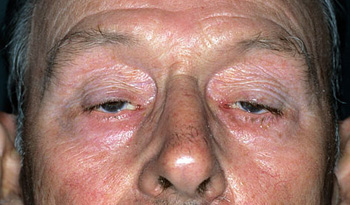Welcome to the latest in our series of informational blog posts which look at various different autoimmune conditions. Today we are exploring Myasthenia gravis – looking in more detail at the signs, symptoms and treatments of this condition. To find out more about autoimmune conditions in general please have a look at our previous post on the subject https://patienttalk.org/?p=939.
As always if you are concerned that you have any of the symptoms of Myasthenia gravis we would advise you to see a healthcare professional as soon as possible.
So what is Myasthenia gravis?
It is an autoimmune condition which affects 1 in 10,000 people in the UK; according to the NHS. Interestingly it seems to, typically, effect women under 40 years of age and men over 60.
Simply put it is a condition which leads to muscle weakness. In particular voluntary muscles which control the movement of things like chewing and swallowing as well as the eyelids. In more serious cases it can affect those muscles used in breathing.
Typical symptoms include:-
Problems with the eyes are often the first noticeable symptom. This could include double or blurred vision. Droopy eye lids are also common.
Dysphagia or difficulty swallowing. This often leads to slurred speech. Again a common symptom.
Breathing difficulties in bed or when exercising.
A myasthenia crisis can occur because of swallowing or breathing issues and leads to hospitalisation
Movement issues such as difficulty walking or a drooping head. This makes physical labour harder for the patient.
Myasthenia gravis occurs because the body’s immune system creates proteins which attach the muscle receptors.
Treatments typically consist of immunosuppressants and if symptoms persist a steroid treatment may be employed. In a few rare cases, where the patient is over 60, it may be considered necessary to remove the thymus gland in an operation called a Thymectomy. This operation can help the immune system rebalance itself. Where problems with swallowing have become very serious then intravenous immunoglobulin therapy could be applied in a hospital setting.
Do you have Myasthenia gravis? If so we would love it if you could tell your story. Please use the comments section below to share anything you think will be of interest. In particular please could you think about the following questions:-
1) What were your first symptoms of Myasthenia gravis?
2) How were you diagnosed? How long did it take and were any other conditions ruled out?
3) What treatments have you received and who effective were they?
4) What was the effect of Myasthenia gravis on your lifestyle?
5) What one piece of advice would you give to somebody who has just been diagnosed with Myasthenia gravis?
Many thanks in advance for all your help!
| LyneneLGros | I was 2 1/2 yrs old when i was diagnosed. Im 41 and have never lived with this disease. My mother was told i would die at 15. Im a walking and seeing miracle! God has healed me. Ill always owe him my life for giving me life. |
| mamajanie | In my hubs case eye issue was in 2010…drooping lid double vision…dr. visit yeilded a prism in lens….over the years weakness…started c-pap june 2013 with developing jaw issues, and throat, allergies…ent dr. Found nothing…heart lung Dr. Foynd nothing…fell 2-3 times…neuroligist diag. Mg sep. 2013…intensive care un oct….ivig caused severe kudney failure…now on dialysus…mestinon helped tempirarily..steroids cause bad side effects…high blood sugar |
